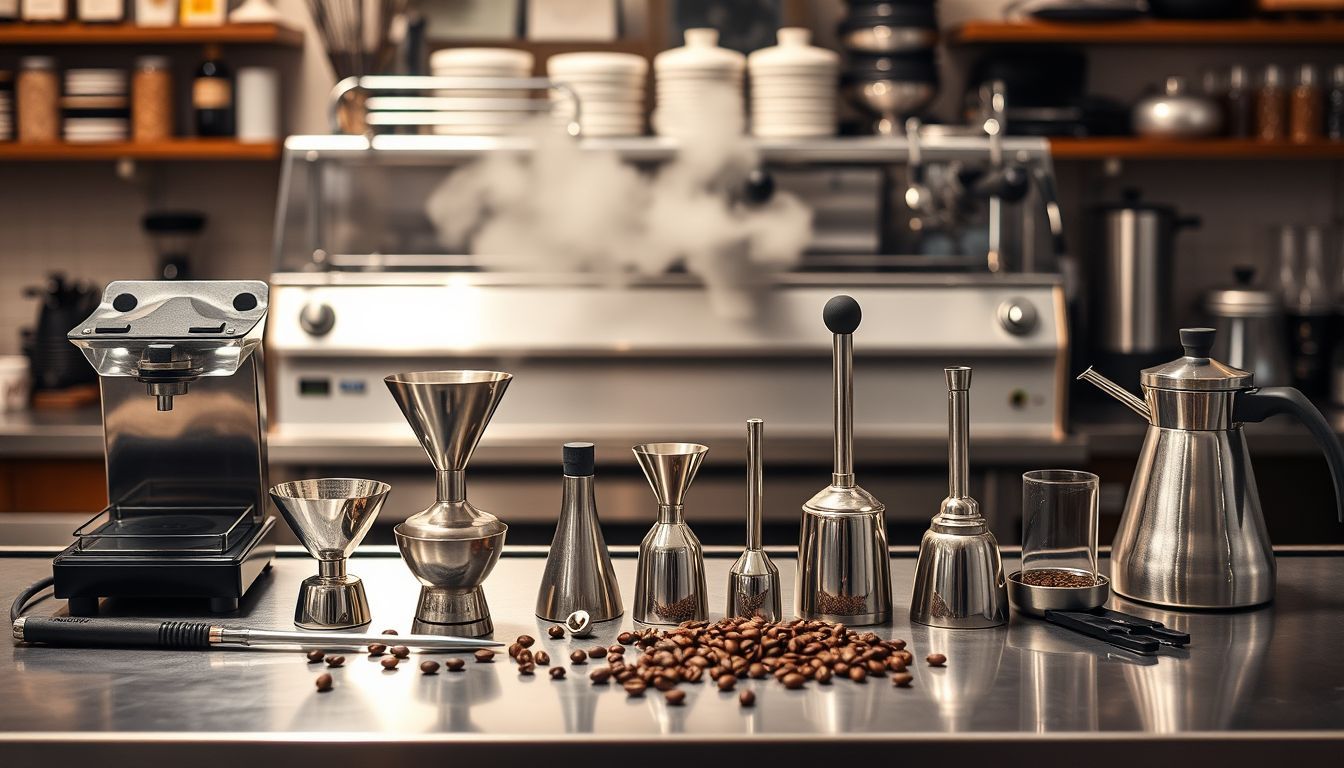Coffee Equipment That's Actually Dishwasher Safe (And What You Should Never Put In There)
Stop hand-washing everything! Discover which coffee gear can handle the dishwasher and which pieces will meet their doom in the rinse cycle.

Amazon Affiliate Disclosure
This post contains affiliate links. If you purchase through these links, we may earn a small commission at no additional cost to you.
Last month, I watched a friend carefully hand-wash her stainless steel French press for the third time that week, muttering about coffee oils and proper maintenance. When I mentioned that her particular model was completely dishwasher safe, she stared at me like I’d just suggested putting her grandmother’s china in a rock tumbler.
“But it’s coffee equipment,” she protested. “Isn’t it all supposed to be hand-washed?”
This conversation crystallized something I’ve noticed throughout years of testing coffee gear: there’s a pervasive myth that all coffee equipment requires delicate, hand-washing treatment. While some pieces absolutely do need gentle care, many modern coffee tools are engineered to survive—and even thrive—in the dishwasher’s harsh environment.
As someone who has systematically destroyed coffee equipment in the name of science (and occasionally by accident), I’ve learned which pieces can handle the dishwasher’s heat, detergent, and mechanical action, and which will emerge looking like they’ve been through a coffee apocalypse.
Today, we’re separating dishwasher fact from fiction, exploring the engineering behind dishwasher-safe coffee gear, and building a definitive guide to what can go in the machine and what absolutely cannot.
The Science of Dishwasher Safety
Before diving into specific equipment, let’s understand what makes something truly dishwasher safe versus merely dishwasher tolerant.
The Dishwasher Environment
Modern dishwashers are essentially controlled chaos chambers. They subject contents to:
• High Temperatures: Water reaches 140–160°F during wash cycles, with heated dry cycles pushing air temperatures even higher.
• Aggressive Detergents: Commercial dishwasher detergents are alkaline and designed to break down proteins and fats—including the coffee oils we sometimes want to preserve.
• Mechanical Action: High-pressure water jets create significant mechanical stress, especially on lightweight or poorly secured items.
• Rapid Temperature Changes: The transition from hot wash to cooler rinse creates thermal stress that can crack or warp certain materials.
Material Considerations
• Stainless Steel: Generally excellent dishwasher performance, though quality matters. 18/8 or 18/10 stainless handles dishwashers beautifully.
• Borosilicate Glass: Laboratory-grade glass resists thermal shock and chemical attack, making it dishwasher friendly.
• High-Grade Plastics: BPA-free plastics marked with recycling codes 1, 2, 4, and 5 typically handle dishwashers well.
• Problematic Materials: Aluminum (can discolor), cheap plastics (may warp), wood (will crack), and delicate glass (risk of thermal shock).
Definitely Dishwasher Safe: The Green Light List
Stainless Steel French Presses
Examples: All-Clad, Frieling, Bodum Columbia
Why they work: Quality stainless steel construction handles dishwasher conditions without issue. The mesh filters actually benefit from the aggressive cleaning action, which removes coffee oils more effectively than hand washing.
Dishwasher tips:
- Disassemble completely for thorough cleaning
- Place filter screens in silverware basket to prevent warping
- Use normal cycle; heated dry is fine
Performance note: One standout is the MuellerLiving French Press Coffee Maker, 34oz, which thrives in the dishwasher.
Borosilicate Glass Pour-Over Drippers
Examples: Hario V60 (glass versions), Chemex, Bodum Pour Over
Why they work: Borosilicate glass is engineered for laboratory use and handles thermal shock exceptionally well. The simple geometry means no trapped areas for detergent buildup.
Dishwasher tips:
- Top rack only to avoid extreme heat exposure
- Secure well to prevent movement during wash cycle
- Skip heated dry if you’re paranoid about thermal stress
Recommended: For a dishwasher-friendly glass option, try the Chemex Pour-Over Glass Coffeemaker – Classic Series – 8-Cup.
High-Quality Plastic Brewing Equipment
Examples: AeroPress, Hario V60 plastic drippers, Clever Dripper
Why they work: Modern coffee equipment uses engineering-grade plastics designed to handle temperature extremes and chemical exposure.
Dishwasher performance: I’ve dishwashed AeroPress Original Coffee and Espresso-Style Maker over 500 times with no degradation.
Best practices:
- Top-rack placement reduces heat exposure
- Avoid heated dry cycles for maximum longevity
- Check for any manufacturer warnings on specific models
Stainless Steel Travel Mugs and Thermal Carafes
Examples: Hydro Flask, Yeti, Contigo
Why they work: Double-wall stainless construction is inherently dishwasher friendly. The sealed design prevents water intrusion that could damage insulation.
Special considerations:
- Remove all rubber seals and gaskets before washing
- Check manufacturer guidelines for lids with electronic components
- Some brands void warranties for dishwasher use—read the fine print
Convenient pick: The Contigo West Loop Stainless Steel Travel Mug, 16oz is perfect for top-rack duty.
Porcelain Coffee Drippers and Small Accessories
Examples: Ceramic drip cones, porcelain filters
Why they work: High-quality porcelain with properly vitrified glazes resists water absorption and mechanical stress.
Dishwasher tips:
- Top rack only
- Avoid direct spray to prevent chipping
- Inspect regularly for glaze damage
Thermal Carafes
Examples: Cresimo, Zojirushi, Cuisinart
Why they work: Vacuum-insulated carafes with glass liners or full stainless walls handle the dishwasher’s heat and detergent.
Dishwasher tips:
- Top rack only if height permits
- Remove pump assemblies or pour-through lids for separate hand washing
- Use standard cycle; avoid eco cycles that limit heat
Try the large Cresimo Coffee Carafe with Pump – 102oz / 3L for reliable thermal performance.
Stainless Steel Milk Frothing Pitchers
Examples: Rattleware, Rhinowares, Barista Hustle
Why they work: Simple stainless steel construction with no moving parts or delicate components.
Dishwasher benefits: The aggressive cleaning action actually helps remove milk protein buildup that can affect frothing performance.
Proceed with Caution: The Yellow Light List
Ceramic and Porcelain Equipment
Examples: Ceramic V60s, porcelain drippers, ceramic French presses
Risks: Crazing, chipping, metallic accents may tarnish
Best practices: top rack only, avoid heated dry, inspect for damage
Espresso Machine Portafilters and Baskets
Why sometimes: Baskets are stainless and dishwasher tolerant, but handles with wood or plastic grips may suffer
My approach: Baskets in the dishwasher, handles hand washed
Silicone Accessories
Examples: Gaskets, flexible drippers
Generally safe but quality varies; if silicone smells or feels sticky after washing, hand wash only
Absolutely Never: The Red Light List
• Wooden equipment (handles, scoops)
• Aluminum (oxidation/discoloration)
• Electronic components (scales, thermometers)
• Thin, delicate glass (vintage pieces)
• Knife-edge grinder burrs (dulling risk)
Dishwasher Best Practices for Coffee Equipment
• Top-rack priority for moderate heat & gentler jets
• Secure placement to prevent movement
• Disassemble multi-part items
• Normal cycle is sufficient; eco cycles can be gentler
• Standard detergents strip coffee oils; avoid bleach
Conclusion: Embracing Dishwasher Freedom
Modern coffee equipment engineering has produced numerous pieces that not only survive dishwasher treatment but perform better with the thorough cleaning that dishwashers provide. By understanding your gear’s capabilities—and choosing the right tools—you can maintain excellent coffee quality while reclaiming time for more important things, like actually drinking the coffee you’ve brewed.
What’s your experience with dishwashing coffee equipment? Have you discovered any surprising successes or failures? I’m always interested in real-world testing results from fellow coffee enthusiasts.

Sofia Rossi
I started my career in a world of spreadsheets and boardrooms, but I quickly realized the most interesting data was in the way people interacted when the pressure was on. My novels are my way of analyzing the human heart—the messy, complicated, and often hilarious parts. I write about the lives we lead now, with all the love, ambition, and absurdity that comes with it.


